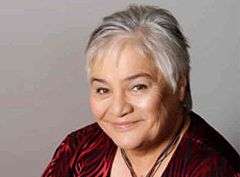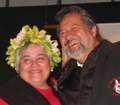Tariana Turia
Dame Tariana Turia DNZM (born 8 April 1944) is a New Zealand politician. She gained considerable prominence during the foreshore and seabed controversy, and eventually broke with her party as a result. She resigned from parliament, and successfully contested a by-election in her former electorate as a candidate of the newly formed Māori Party. She retired from Parliament in 2014.
Dame Tariana Turia DNZM | |
|---|---|
 | |
| 1st Minister responsible for Whānau Ora | |
| In office 8 April 2010 – 8 October 2014 | |
| Prime Minister | John Key |
| Succeeded by | Te Ururoa Flavell |
| Minister for the Community and Voluntary Sector | |
| In office 19 November 2008 – 12 December 2011 | |
| Prime Minister | John Key |
| Preceded by | Ruth Dyson |
| Succeeded by | Jo Goodhew |
| Minister for Disability Issues | |
| In office 13 June 2009 – 8 October 2014 | |
| Prime Minister | John Key |
| Preceded by | Paula Bennett |
| Succeeded by | Nicky Wagner |
| Co-leader of the Māori Party | |
| In office 7 July 2004 – September 2014 | |
| Preceded by | Position established |
| Succeeded by | Marama Fox |
| Member of the New Zealand Parliament for Labour Party List | |
| In office 12 October 1996 – 27 July 2002 | |
| Member of the New Zealand Parliament for Te Tai Hauāuru | |
| In office 27 July 2002 – 20 August 2014 | |
| Preceded by | Nanaia Mahuta |
| Succeeded by | Adrian Rurawhe |
| Majority | 5,113[1] |
| Personal details | |
| Born | 8 April 1944 |
| Political party | Māori Party (2004-) Labour (until 2004) |
| Spouse(s) | George Turia |
Early work
Turia was born in 1944 to an American (probably Native American) father[2] and Māori mother. Her Māori roots are Ngāti Apa, Ngā Rauru, and Tūwharetoa iwi, among others.
She is married to George Turia. They have 4 children, 2 whāngaia, and 28 grandchildren, and great grandchildren.
Before entering politics, she had considerable involvement with a number of Māori organisations, working with Te Puni Kōkiri (the Ministry of Māori Development) and a number of Māori health providers. She also had associations with the Te Kura Kaupapa and kohanga reo movements.
Member of Parliament
| New Zealand Parliament | ||||
| Years | Term | Electorate | List | Party |
| 1996–1999 | 45th | List | 20 | Labour |
| 1999–2002 | 46th | List | 16 | Labour |
| 2002–2004 | 47th | Te Tai Hauāuru | None | Labour |
| 2004–2005 | 47th | Te Tai Hauāuru | Māori | |
| 2005–2008 | 48th | Te Tai Hauāuru | 1 | Māori |
| 2008–2011 | 49th | Te Tai Hauāuru | 1 | Māori |
| 2011–2014 | 50th | Te Tai Hauāuru | 7 | Māori |
Turia entered the New Zealand Parliament in the 1996 election as a list MP for the Labour Party, ranking 20th on the party list. In the 1999 election, she remained a list MP, but ranked sixteenth. In the 2002 election, however, she contested the Te Tai Hauauru Māori electorate, and opted not to place herself on the party list at all. Te Tai Hauauru (roughly, the Māori voters of the west of the North Island) returned her as their member of parliament.
Although never a member of Cabinet, Turia has held a number of non-Cabinet ministerial roles. From Labour's electoral victory in 1999, she served as Associate Minister of Māori Affairs, Associate Minister of Social Services and Employment, Associate Minister of Health, and Associate Minister of Housing. In 2002, she also became Associate Minister of Corrections. After the formation of the Labour-Progressive coalition in 2002, she dropped the Corrections role and gained full ministerial rank as Minister for the Community and Voluntary Sector.[3]
Foreshore and seabed legislation
When debate about ownership of New Zealand's foreshore and seabed broke out in 2003, and the Labour Party proposed vesting ownership in the state, Turia voiced dissatisfaction. Along with many of her supporters in Te Tai Hauauru, she claimed that Labour's proposal amounted to an outright confiscation of Māori land. When it became publicly known that Turia might vote against Labour's bill in parliament, tensions between Turia and the Labour Party's leadership increased. The hierarchy strongly implied that if Turia did not support Labour policy, she could not retain her ministerial roles.
By-election
On 30 April 2004, after a considerable period of confusion about Turia's intentions, she announced that she would resign from parliament on 17 May. This precipitated a by-election being called in Te Tai Hauauru, which Turia contested as a member of the new Māori Party that formed around her. On the same day that Turia announced her resignation, Prime Minister Helen Clark sacked her from her ministerial posts.[4]
Her supporters see Turia as having bravely defied her party in order to stand up for her principles. The Labour Party has criticised Turia for putting the foreshore and seabed issue before the party's wider policies for Māori development, and says that she has unreasonably focused on a single issue. Helen Clark said that Turia had shown "an astonishing lack of perspective".[4] Turia described the Te Tai Hauauru by-election of 10 July 2004 as a chance to test her mandate, and to ensure that she had the support of her voters, but doubts remained about the significance of the by-election, since none of the major parties put forward candidates. Labour called the event "a waste of time and money", although the by-election was required by waka-jumping law in force at the time.[5]
Turia received 92.74% of the vote in the by-election,[6] and resumed her seat in Parliament on 27 July 2004.
2005 general election

On 17 September 2005, the Māori Party contested the general election with electoral candidates in all seven of the Māori seats. Turia was re-elected in Te Tai Hauauru and that night three more Māori Party candidates won parliamentary seats, Pita Sharples (co-leader) in Tamaki Makaurau, Hone Harawira in Te Tai Tokerau and Te Ururoa Flavell in Waiariki. The winning of the four seats resulted in celebration for their supporters who anticipated seeing an independent, Māori voice in parliament. However, the Māori Party share of the party vote across the country was 2.1 percent, placing them sixth out of the eight parties in parliament by party vote. This was attributed to voters in the Māori electorates mainly giving their party vote to the incumbent Labour government.
2008 general election and ministerial posts
Support for the Māori Party in the 2008 general election increased with the party gaining an additional seat.[7] National won most seats overall, to form a minority government with support from the Māori Party as well as ACT New Zealand and United Future. In return for Māori Party support in confidence and supply, John Key agreed to not abolish the Māori seats without the consent of Māori.[8] It was also agreed to review the Foreshore and Seabed Act 2004 and to consider Māori representation in a wider constitutional review which began in 2010.[9] Turia and co-leader Sharples were both made Ministers, although like other support party members both remained outside Cabinet. Turia was given the portfolios of Minister for the Community and Voluntary Sector, Associate Minister of Health and Associate Minister for Social Development and Employment, while Sharples was made Minister of Māori Affairs.[10]
When Paula Bennett stepped down as Minister for Disability Issues on 30 June 2009, Key appointed Turia the new minister.[11] In 2010, the National and Māori Parties announced Whānau Ora, a taskforce designed to streamline social service resources. Turia was announced Minister responsible for the implementing of the scheme.[12]
On 7 April 2011, during the term of the 49th New Zealand Parliament, the composition of the Abortion Supervisory Committee was debated. Turia moved that an anti-abortion Pacific Island doctor, Ate Moala, be appointed to the ASC. The vote was lost 70–30 against, with twenty absences or abstentions.[13]
Turia confirmed in November 2013 that she would retire at the 2014 election.[14]
Honours
In the 2015 New Year Honours, Turia was appointed a Dame Companion of the New Zealand Order of Merit for services as a Member of Parliament.[15]
References
- "Elections NZ 2005: Official Count Results – Te Tai Hauauru". Archived from the original on 11 October 2007.
- "Michele Hewitson interview: Tariana Turia". New Zealand Herald. 5 March 2011. Retrieved 15 May 2011.
-
- Profile at New Zealand Parliament
- Releases and speeches at Beehive.govt.nz
- Berry, Ruth; Tunnah, Helen (30 April 2004). "Turia quits Labour, stripped of portfolios". The New Zealand Herald. Retrieved 29 July 2020.
- Professor Andrew Geddis. "Who controls the past now, controls the future". Retrieved 11 January 2017.
- "By-Election Results -- Te Tai Hauauru". Chief Electoral Office. Retrieved 19 September 2014.
- "Party vote status 2008". Archived from the original on 9 February 2009.
- Trevett, Claire (17 November 2008). "Maori Party takes 'sensible position'". The New Zealand Herald. Retrieved 17 November 2011.
- "Key's Government". The New Zealand Herald. 17 November 2008. Retrieved 17 November 2011.
- "Minister drops Disability Issues" (Press release). New Zealand Labour Party. 30 June 2009. Retrieved 8 April 2010.
- "Whanau Ora: Turia to head welfare shake-up". The New Zealand Herald. 8 April 2010. Retrieved 8 April 2010.
- "Politics, latest political news and analysis - National". The New Zealand Herald.
- Small, Vernon (5 November 2013). "Tariana Turia set to go". Stuff.co.nz. Retrieved 19 September 2014.
- "New Year honours list 2015". Department of the Prime Minister and Cabinet. 31 December 2014. Retrieved 13 January 2018.
External links
| Wikimedia Commons has media related to Tariana Turia. |
- Te Tai Hauāuru
- Profile at Māori Party
| New Zealand Parliament | ||
|---|---|---|
| Preceded by Nanaia Mahuta |
Member of Parliament for Te Tai Hauāuru 2002–2014 |
Succeeded by Adrian Rurawhe |
| Party political offices | ||
| New political party | Co-leader of the Māori Party 2004–2014 Served alongside: Pita Sharples, Te Ururoa Flavell |
Succeeded by Marama Fox |
| Political offices | ||
| Preceded by Ruth Dyson |
Minister for the Community and Voluntary Sector 2008–2011 |
Succeeded by Jo Goodhew |
| Preceded by Paula Bennett |
Minister for Disability Issues 2009–2014 |
Succeeded by Nicky Wagner |
| New ministerial post | Minister responsible for Whānau Ora 2010–2014 |
Succeeded by Te Ururoa Flavell |
